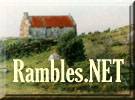|
Brian Selznick, The Invention of Hugo Cabret (Scholastic Press, 2007) There was a frequent segue phrase used on Monty Python's Flying Circus -- "And now, for something completely different..." -- and I feel like that this book fits that perfectly.
The story itself is done well, with interesting characters, a breathtaking pace and a good degree of plot complexity, especially with how the secrets are gradually uncovered and have fascinating interconnections and ramifications that stretch well beyond the characters. However, that is not what makes this book stand out. What does move this book into the category of "And now, for something completely different?" The format! By topical genre, this book is a mystery, aimed at ages 6 to 96, but the presentation is something I have never seen before. I have read books where illustrations are an important adjunct to the text. A good example is How to Keep Dinosaurs by Robert Mash. I have read good graphic novels, with The Hedge Knight by George R.R. Martin being a prime example. The Asterix & Obelix books are good examples of comic books with enough mature connotations and subtexts that they appeal to some adults. I have not yet read or seen The Arrival by Shaun Tan, which is a virtually textless tales of the struggles of an immigrant adjusting to a new culture, but The Invention of Hugo Cabret is not that, either, as text is an integral part of the story. The Invention of Hugo Cabret is something else, yet again. Of its 525 pages, roughly 300 pages are beautiful illustrations, mainly complex, detailed pencil drawings by the author, Brian Selznick. Selznick was an illustrator before he became an author, and his skill and love for the visual medium sings loudly and clearly in this work of art. A typical sequence features a series of sequential drawings, perhaps covering seven or eight pages, presenting a key piece of the story, followed by an interlude of two to four pages of text that often features dialogue and background history, presented by one or more of the characters as they pry at, unearth and unravel each other's interrelated secrets. Even the paper speaks of the author's love of art, as it is all wood-free, woven paper that is heavy and semi-glossy in texture. I would love to stroll through a museum with this story, presented large, displayed upon the walls, probably underground, with dark and light areas, illumination-wise, and the hallways twisting and turning. If it were presented that way, many visitors would end up running through, as they get entranced by and caught up in this well-told story of tragedy, buried history and triumph. They would want to devour it as fast as possible, and then run right back through. 
 |
 Rambles.NET review by Chris McCallister 1 November 2008 Agree? Disagree? Send us your opinions! 





|

